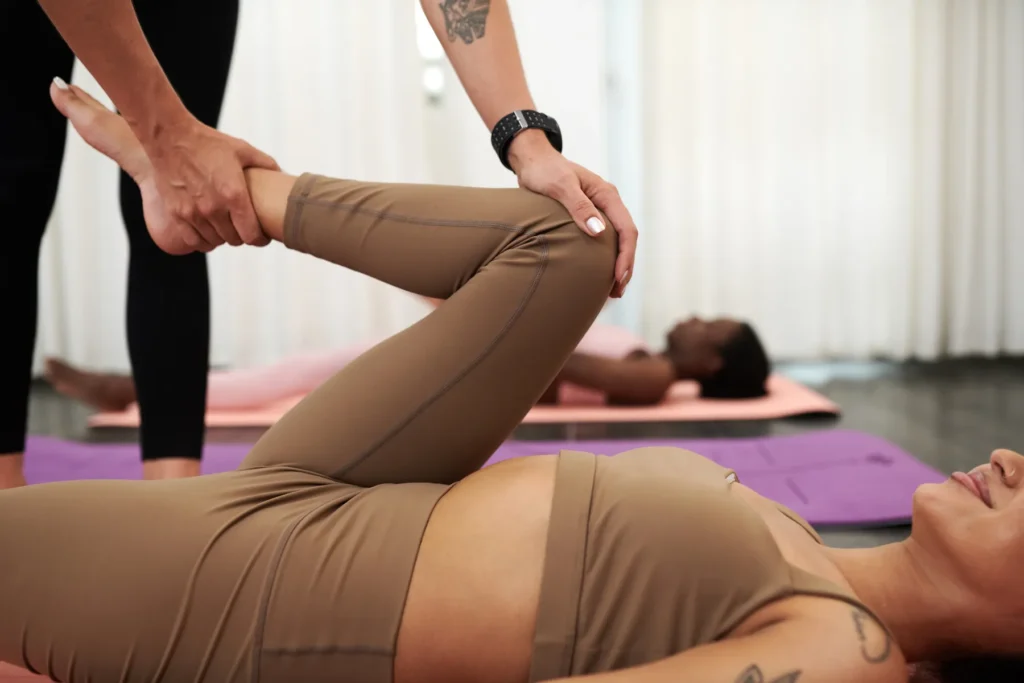Introduction
Yoga has gained immense popularity worldwide for its numerous physical and mental health benefits. From improving flexibility and strength to reducing stress and promoting relaxation, the practice offers a holistic approach to well-being. However, like any physical activity, yoga carries the risk of injury. Understanding these potential injuries is crucial for practitioners to ensure a safe and fulfilling practice. This article will explore the five most common yoga injuries, their causes, prevention strategies, and treatment options. Read our latest blog on Yoga Retreats 2024.
Here are the 5 Most Common Yoga Injuries:
- Strains and Sprains
- Wrist Injuries
- Lower Back Pain
- Shoulder Injuries
- Hamstring Strains
C0mmon Yoga Injuries and Their Causes, and Recovery Treatment
1. Strains and Sprains
Strains and sprains are among the most prevalent injuries encountered in yoga. These injuries typically involve stretching or tearing muscles (strains) or ligaments (sprains), often resulting from overexertion or improper alignment during asana practice. While yoga is renowned for its therapeutic benefits, it’s crucial to recognize the potential risks associated with pushing the body beyond its limits.
Common Causes:
- Overexertion: Pushing oneself too hard or attempting advanced poses without adequate preparation can strain muscles and ligaments.
- Improper Alignment: Incorrect alignment in poses places undue stress on specific joints and tissues, increasing the risk of strains and sprains.
- Lack of Warm-up: Failing to warm up properly before engaging in vigorous yoga practice can leave muscles tight and vulnerable to injury.
Prevention Strategies:
- Proper Alignment Cues: Emphasize the importance of alignment cues to ensure students maintain correct posture and distribute weight evenly, reducing the risk of strain on vulnerable areas.
- Warm-up Exercises: Incorporate dynamic warm-up exercises such as sun salutations or gentle stretches to prepare the body for more intense movements and promote blood flow to muscles and ligaments.
- Modifications: Encourage students to modify poses according to their abilities and limitations, allowing them to gradually build strength and flexibility while minimizing the risk of injury.
Treatment Options:
- I.C.E. Method: Advocate for using the R.I.C.E. (Rest, Ice, Compression, Elevation) method immediately following an injury to reduce inflammation and promote healing.
- Rest: Stress the importance of allowing the injured area to rest and recover before attempting to resume regular yoga practice.
- Gradual Return to Practice: Advise students to reintroduce yoga gradually, starting with gentle, modified poses and progressively increasing intensity as the injury heals.
2. Wrist Injuries
Wrist injuries encompass a range of conditions, including strains, sprains, and overuse injuries such as tendonitis and carpal tunnel syndrome. These ailments often manifest as pain, stiffness, or weakness in the wrists, hindering the execution of various yoga poses and compromising overall practice enjoyment.
Contributing Factors:
- Excessive Weight Bearing: Placing excessive weight on the wrists, particularly in weight-bearing poses like planks or downward-facing dogs, can strain the delicate structures of the wrist joints.
- Incorrect Hand Placement: Improper alignment, such as collapsing the wrists inward or hyperextending them, increases the risk of injury during yoga practice.

Prevention Techniques:
- Wrist-Strengthening Exercises: Integrate wrist-strengthening exercises into your routine to build stability and resilience in the wrists, reducing the likelihood of injury. Examples include wrist curls, wrist extensions, and forearm planks.
- Proper Alignment: Emphasize adequate hand placement and alignment in weight-bearing poses, distributing weight evenly across the palms and engaging the muscles of the hands and forearms for support.
- Props Usage: Utilize yoga props such as blocks, straps, or wedges to modify poses and alleviate excess pressure on the wrists. Props can provide additional support and facilitate safe alignment, particularly for practitioners with wrist sensitivity or injury history.
Treatment Approaches:
- Rest: Allow the wrists ample time to rest and recover from overuse or acute injury. Refrain from activities exacerbating pain or discomfort, and avoid bearing weight on the affected wrists.
- Wrist Stretches: Incorporate gentle wrist stretches into your daily routine to improve flexibility and mobility in the wrists. Simple exercises like wrist circles, wrist flexor and extensor stretches, and prayer pose stretches can help alleviate tension and promote healing.
- Modifications in Practice: Modify yoga poses as needed to reduce strain on the wrists. Options include using fists or forearms for support in place of flat palms or utilizing props to modify weight-bearing poses.
3. Lower Back Pain
Yoga practitioners frequently have lower back pain due to repetitive strain, muscle imbalances, or poor alignment. This discomfort can range from minor stiffness to terrible pain, limiting movement and yoga benefits.
Causes:
- Overstretching: Stretching excessively or improperly, especially in forward bends or twists, can cause tension in the lower back’s muscles and ligaments, resulting in discomfort and even injury.
- Improper Alignment: In yoga postures that cause misalignment, such as rounding or overarching the lower back, the lumbar spine and adjacent structures are subjected to excessive strain, contributing to discomfort and instability.
- Weak Core Muscles: By undermining spinal support and alignment, inadequate strength and stability in the core muscles (abdominals, obliques, and back extensors) may increase susceptibility to lower back discomfort.
Prevention Methods:
- Incorporate core-strengthening postures into your routine, including plank, boat, and bridge, to strengthen the muscles responsible for supporting the vertebrae and enhancing stability in the lower back.
- It is crucial to adhere to the alignment cues that instructors offer. These cues emphasize the importance of maintaining a neutral spine and engaging the core muscles to safeguard the lower back while performing poses.
- Applying yoga props, including bolsters, harnesses, or blocks, can be beneficial in adjusting poses and ensuring accurate alignment, especially for individuals with restricted lower back flexibility or strength.

Treatment Options:
- Gentle Stretching: By performing light stretching exercises, one can mitigate tension and enhance flexibility in the muscles that envelop the lower back. Cat-cow stretches, supine knee-to-chest stretches, and seated spinal rotations are some examples.
- Strengthening Exercises: Integrate incremental strengthening routines that specifically target the core and back muscles to enhance the stability and resilience of the lower back. Concentrate on exercises that require controlled movement and proper form, such as the bird-dog pose and Superman pose.
- Professional Guidance: It is advisable to consult a healthcare professional or a certified yoga instructor for assistance with persistent or severe lower back discomfort. Specialized guidance, modifications, or therapeutic interventions may be provided to cater to individual requirements and promote recovery.
4. Shoulder Injuries
These injuries are commonly observed among individuals who engage in yoga and can manifest as various conditions, such as tendonitis, shoulder impingement syndrome, and rotator cuff strains. Shoulder pain, stiffness, or fatigue are frequent symptoms of these injuries, which impair shoulder mobility and stability during asana practice.
Causes:
- Overuse: Engaging in repetitive weight-bearing postures, such as chaturanga or downward dog, without sufficient recuperation time and rest may give rise to overuse injuries in the shoulder region. These injuries manifest as muscular and tendional strain and inflammation.
- Improper Alignment: Misalignment during yoga sequences, including shoulder collapses and upper back rounding, exacerbates the strain on the shoulder joints and soft tissues, thereby prolonging the potential for injury.
Prevention Strategies:
- Shoulder-Strengthening Exercises: Integrate shoulder-strengthening exercises into your yoga regimen to enhance shoulder girdle stability and resilience. Concentrate on shoulder external rotations, shoulder presses, and scapular retractions, which target the rotator cuff muscles, deltoids, and scapular stabilizers.
- Proper Alignment Cues: It is imperative to diligently adhere to alignment signals presented by instructors, focusing on shoulder positioning and pose engagement to minimize strain and facilitate optimal biomechanics.
- Modifications: Adjust yoga postures to mitigate shoulder strain and accommodate unique physical limitations. Props such as blankets, blocks, or straps can reduce excessive joint tension and promote proper alignment.

Treatment Approaches:
- Rest: Provide adequate time for the shoulders to recuperate from acute injury or overuse. Until symptoms subside, avoid engaging in activities that exacerbate shoulder pain and inflammation, and avoid weight-bearing poses.
- Shoulder Stretches: To enhance shoulder flexibility and mobility, integrate daily shoulder stretches that are performed gently. Some examples include shoulder rolls, arm rotations, and stretches of the shoulder flexors and extensors.
- Strengthening Exercises Under Professional Supervision: Incorporate shoulder-specific strengthening exercises gradually back into your routine with the supervision of a certified yoga instructor or physical therapist. Concentrate on exercises that foster the development of balanced muscles and correct shoulder mechanics, increasing resistance and intensity progressively as tolerated.
5. Hamstring Strains
Hamstring strains are characterized by discomfort, stiffness, and decreased mobility; they are caused by overstretching or tearing of the muscles at the back of the thigh. Within yoga, where forward folds and leg stretches are routine occurrences, the hamstrings are especially prone to strain due to the repetitive and flexibility-required characteristics of these movements and postures.
Causes:
- Overstretching and strain can result from exceeding the limits of the hamstrings or undertaking advanced stretches without sufficient preparation.
- Inadequate Alignment in Forward Folds: Forward folding poses that involve misalignment, such as overreaching or spinal curvature, impose an excessive amount of strain on the hamstrings, thereby augmenting the potential for injury.
Prevention Techniques:
- Gradual Progression in Stretches: Exercise patience and mindfulness while performing hamstring stretches, progressively augmenting the stretch’s intensity over time to prevent abrupt strain or injury.
- Adequate Warm-up: Before commencing vigorous stretching or yoga, integrate a comprehensive warm-up regimen encompassing dynamic movements to stimulate circulation and prime the muscles for stretching.
- Yoga implements, including blankets, straps, and blocks, are recommended for promoting safe stretching and ensuring proper alignment, especially for individuals with restricted flexibility or a predisposition to hamstring tightness.

Treatment Methods:
- Rest and recuperate the strained hamstring muscles by refraining from engaging in activities that worsen pain or distress to reduce the strain on the afflicted muscles; adjust your yoga method.
- Engage in light stretching routines targeting the hamstrings to enhance flexibility and alleviate muscular tension. Concentrate on progressively lengthening the muscles while avoiding bouncing or aggressive movements.
- To enhance hamstring strength and stability, it is recommended to perform targeted strengthening exercises in the company of a qualified instructor or physical therapist. Illustrative instances comprise hamstring curls, bridges, and lunges executed with appropriate form and methodology.
Conclusion:
As we end our yoga injury research, we must consider our findings and how to create a safe and sustainable practice. We’ve discussed yoga’s usual problems, including strains and sprains, wrist ailments, lower back pain, shoulder issues, and hamstring strains.
Recap of the Five Most Common Yoga Injuries:
We’ve explored yoga-related strains/sprains, wrist injuries, lower back pain, shoulder injuries, and hamstring strains. Each has unique challenges and considerations, emphasizing the need to understand their origins and apply effective prevention and treatment techniques.
Emphasis on the Importance of Prevention:
Injury prevention is essential to a healthy yoga practice. Proper alignment, adaptations, and progressive advancement can reduce injury risk and build strength and resilience.
Encouragement for Practitioners to Listen to Their Bodies:
Practitioners must connect with their bodies and respect their limitations above all. Listening to tiny indications of discomfort or strain and seeking professional counsel helps us make educated decisions and prioritize our well-being.
Closing Thoughts on the Holistic Benefits of Yoga:
Remember yoga’s comprehensive advantages as we discuss injury prevention and safe practice. Yoga promotes balance, resilience, and inner serenity in mind, body, and soul. We embrace yoga’s profound journey of self-discovery and development by practicing mindfully.
In essence, let us practice yoga with respect for our bodies, gratitude for their wisdom, and a commitment to safety and sustainability. May our practice be a place of healing, growth, and joy, guiding all to wholeness and well-being.




